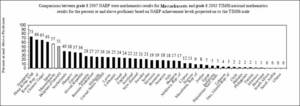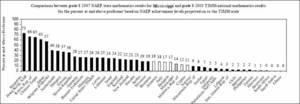
This past week Strong American Schools launched a five million dollar ad campaign in crucial general election states across the country. The radio, television, and print ads depict the current education crisis that our students are now facing -- namely that they are slipping to the middle of the pack when compared to our global competitors. One critical way to fix this problem is to develop and raise our standards throughout the entire United States. The quality of our children's education should not depend on where they live.
American Education Standards
First, it is important to understand the distinction between standards and curriculum when we talk about American Education Standards. Standards are state-established goals which are implemented through a local curriculum to prepare students for life after high school. More specifically, standards describe the knowledge and skills that all students should learn by the end of each grade. Curriculum provides detailed instructions -- such as lesson plans, student projects, and instructional materials -- for teaching the required knowledge and skills as outlined in the standards. Curriculum, as it's described here, should be left up to local educators who can best determine how to teach their students. Among all 50 states, however, there is an urgent need for the United States to raise the rigor of standards so that every student graduates prepared to compete in the global economy.
Case for Action
A generation ago, the academic standards and skills set forth in the American education system were sufficient to prepare high school graduates to succeed in college or the workforce. But, the playing field has changed over the last half decade. In today's global economy, life after high school demands higher skills than ever before. The demand for low-skill jobs has decreased and the demand for high-skill jobs that focus on math and science has increased. More than two-thirds of the new jobs created in our economy require students to go beyond high school and acquire a college education or technical training. White-collar and traditional blue-collar jobs, such as electricians, now require a similar level of academic preparation as college. Unfortunately, our schools have not responded to this changing playing field.
As a result, American students are significantly below average in skills that are important in today's technology-driven economy. Out of 30 countries participating in a 2006 assessment, America's 15-year-olds ranked 25th in math and 21st in science. Even America's top math students rank 25th out of 30 countries when compared with top students elsewhere in the world. Our declining position in academic achievement is not solely the result of our failures, but rather other countries have raised their standards while America has remained stagnant. As recently as 1998, the U.S. ranked first in percentage of 25-34 year olds with at least a bachelor's degree, but by 2005 it had dropped to 7th.
Raising America's education standards is a serious challenge that requires broad, national action to ensure students across the country graduate prepared for college, work, and life. This is not to say that there is a one-size-fits-all solution to the problem; but, the current system of 50 states with 50 different sets of standards is not providing students with the skills they need to be successful. We need strong, cooperative leadership at all levels to modernize the current educational system.
Take for example, mathematics. Many states are setting the bar as low as possible in order to comply with the Adequate Yearly Progress (AYP) requirements of No Child Left Behind. A recent study by the U.S. Department of Education found that out of 32 states, only three had set performance benchmarks for 8th grade math that were high enough to meet the proficient level on the National Assessment of Educational Progress (NAEP).
Internationally, we see the same problem. A study which compared NAEP results with data from the Trends in International Mathematics and Science Study (TIMSS) found that the highest achieving states within the United States are significantly below the highest achieving countries, and the variation in performance among states is just as great.
Plan for Action
America needs a national effort to raise education standards in every state. This does not imply Washington should dictate to state and local governments what should be done in the classroom (i.e. curriculum). This country has had a long history of local control and this essential model should be maintained. But states cannot, and are not, competing individually in the global economy. The federal government has the resources to help states create a plan of action that will even the playing field with the top-performing countries in today's flat and digitized world. The federal government can work with a group of states to create model standards for other states to adopt on a voluntary basis, while providing the states with strong incentives for adopting these internationally benchmarked expectations. That way, the rigorous core standards we need would be coming from the states themselves and not "from the feds." Here is how it might work:
•The next president holds a national summit within the first 30 days of taking office to challenge the governors and state education leaders to raise K-12 standards. He would challenge the states to work in smaller groups (say 15) to draft a set of common standards--based on international benchmarking work already underway in some states--that would serve as a voluntary model for others.
•The consortium of states could use as a starting point the college- and workplace-skills readiness benchmarks developed by the American Diploma Project (ADP), which are already used to create standards in math and language arts by the 33 states in the ADP Network.
•They would agree to benchmark the standards annually against the highest performing nations in the world (such as other industrialized nations participating in the Programme for International Student Assessment).
•Other states could join the consortium at any time.
•The federal government would give the states incentives to adopt the model standards, such as paying for assessments designed to measure performance against the standards (and reimbursement for cost of test administration), or a new deal under NCLB with different timelines and accountability provisions to support meeting the higher standards.
•After two years, the Secretary of Education will publish an annual report showing the expectation gaps between state standards and the model standards, and between state assessment benchmarks and the NAEP assessment benchmarks, highlighting states with the largest gaps.
The public will for common, rigorous standards already exists. A survey conducted in 2007 found that nearly three-quarters of the American public (73 percent) support one test and one set of standards for all students, compared with only 27 percent who support different tests and standards in different states. A survey conducted last month of registered voters in Ohio and Missouri found that more than three-quarters would like to see the federal government have some responsibility in urging higher academic expectations for schools and leaders.
Common, rigorous standards will help ensure that all students leave high school prepared not just for their own state's labor market but also for jobs across the country and around the globe. In today's wired and digitized world, jobs can be done virtually anywhere, so the best opportunities will go to the best educated, no matter where they live. As this trend continues and millions of students in China and India enter the workforce with better skills than students from the U.S., we will quickly lose our ability to compete economically and the American dream will disappear. We must find the political will to solve this crisis.
Marc Lampkin serves as the Executive Director of Strong American Schools. For more information, visit www.strongamericanschools.org.


